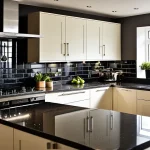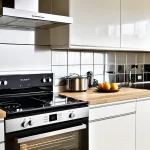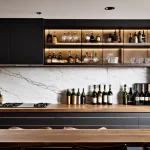Leading lighting trends in UK kitchen design
Explore the latest styles and technologies illuminating UK kitchens
UK kitchen lighting trends in 2024 emphasize a harmonious blend of style, function, and innovation. Homeowners are gravitating toward modern kitchen lighting solutions that enhance both ambiance and practicality. Among the most prominent trends are layered lighting designs, combining ambient, task, and accent lighting for flexibility and depth.
Also read : How Have British Kitchen Trends Evolved Over Recent Years?
Key technologies such as LED and smart lighting systems are revolutionizing how kitchens are lit, allowing for customizable brightness and color temperature that adapts to time of day or activity. Finishes like brass, matte black, and glass elements continue to dominate, offering sleek yet warm aesthetics that complement contemporary cabinetry and surfaces.
Statement fixtures, including oversized pendant lights with metallic accents or minimalistic geometric shapes, act as focal points. These pieces fuse art with utility, often positioned above kitchen islands or dining areas to draw attention and create a sense of intimacy. Incorporating these elements aligns perfectly with the 2024 kitchen design trends, delivering kitchens that are as visually striking as they are efficient.
Also to read : What role do UK kitchens play in the home renovation market?
Influence of Lighting Trends on Kitchen Aesthetics
Lighting is a pivotal element affecting kitchen aesthetics, profoundly shaping the visual impact of lighting on kitchen appearance. It alters colour tones, enhances or softens textures, and shifts spatial perception, making small kitchens feel larger or cozy. For instance, warm LED under-cabinet lights enrich wood grain and stone textures, creating a welcoming atmosphere. Conversely, cool-toned pendant lights can add a modern edge, highlighting sleek surfaces and clean lines often seen in UK contemporary kitchens.
Different lighting techniques also define ambiance. Layered lighting combines ambient, task, and accent lights, balancing function and style. A dimmable overhead fixture sets a relaxed mood for evening meals, while bright task lighting improves visibility for meal prep without compromising aesthetics. In the UK, kitchens transitioning from traditional to modern designs rely on lighting trends to bridge styles, using innovative fixtures to update the overall kitchen appearance without costly renovations.
Ultimately, strategic light placement and fixture selection create dynamic spaces where form and function coexist beautifully, emphasizing how lighting trends continuously evolve and influence kitchen aesthetics. This highlights the critical role of visual impact of lighting in transforming UK kitchen styles.
Smart lighting advancements in UK kitchens
Smart kitchen lighting has rapidly evolved, blending intelligent lighting systems seamlessly into modern UK kitchens. Integration of smart controls and automation allows homeowners to manage lighting through voice commands or smartphone apps, enhancing convenience and customization. For example, motion sensors can switch lights on and off automatically when entering or leaving the kitchen, optimizing energy use with minimal effort.
Energy efficiency plays a vital role in these advancements. New smart kitchen lighting solutions employ LED technology paired with adaptive controls to adjust brightness and color temperature based on natural light levels or time of day. This not only reduces electricity consumption but also creates a more comfortable and welcoming environment.
Responsive systems are designed to cater to various kitchen activities—whether it’s bright, focused lighting for cooking or softer tones for dining and relaxation. By adjusting in real time, these intelligent lighting options improve both mood and practicality, reflecting the latest kitchen technology trends focused on user experience and sustainability.
Overall, smart kitchen lighting in the UK emphasizes control, efficiency, and adaptability, making it a progressive component of contemporary kitchen design.
Practical effects on kitchen design and functionality
Small, well-placed lights are the cornerstone of functional kitchen lighting. In UK kitchen renovations, zoning is essential: separate illumination for food preparation, dining, and entertaining areas ensures each task is clearly lit without confusion. This zoning improves safety and efficiency, especially when chopping ingredients or managing hot surfaces. Layering light sources—ambient, task, and accent—provides balance. Ambient light fills the room, task lighting focuses on workspaces, and accent lighting highlights decorative features without overwhelming practicality.
Practical lighting solutions also boost visibility in key areas like countertops, sinks, and storage spaces. Under-cabinet lights prevent shadows where they matter most, making food prep easier and more enjoyable. Storage areas, including cupboards and pantry shelves, benefit from integrated lighting, which addresses a persistent challenge in kitchen design: poor visibility can lead to wasted time searching for items.
Finally, successful kitchen lighting must balance decorative appeal with functionality. Stylish fixtures can complement the overall design while serving practical, everyday purposes, proving that beauty and usefulness can coexist in modern kitchens.
Expert insights and contemporary case studies
Understanding successful UK kitchen lighting through professional experience
UK kitchen makeovers often hinge on expertly crafted lighting solutions. Designer kitchen lighting transforms spaces by balancing functionality and style. According to UK kitchen design professionals, layering light sources is essential—ambient, task, and accent lighting combined enhance both aesthetics and usability.
Recent kitchen lighting case studies reveal that many homeowners face challenges such as insufficient task lighting over work surfaces or glare from poorly positioned fixtures. Designers recommend integrating under-cabinet LEDs to provide focused illumination where precision is needed. In one notable UK kitchen makeover, a client struggling with a dark cooking area found success by installing adjustable recessed spotlights paired with warm-toned pendant lights, creating a welcoming yet practical environment.
Common solutions in these UK projects include dimmer switches for mood control and smart lighting systems that adapt to different times of day or activities. By examining these kitchen lighting case studies, homeowners can better appreciate the impact of thoughtful lighting choices and avoid typical pitfalls, ensuring their kitchen makeover achieves both beauty and function.




